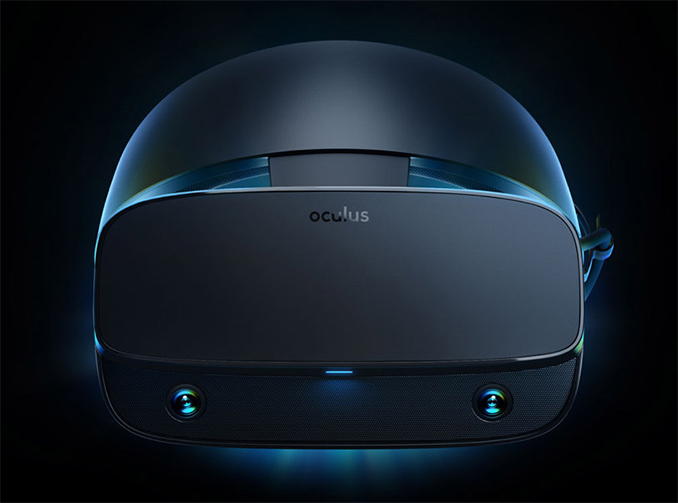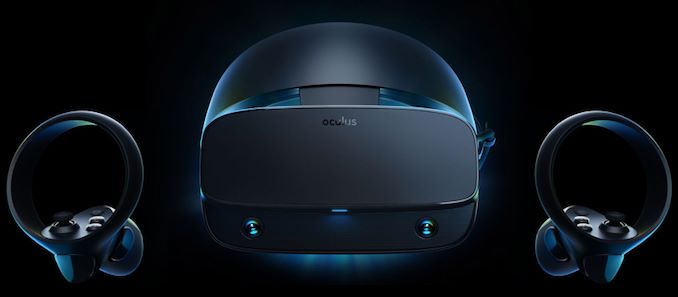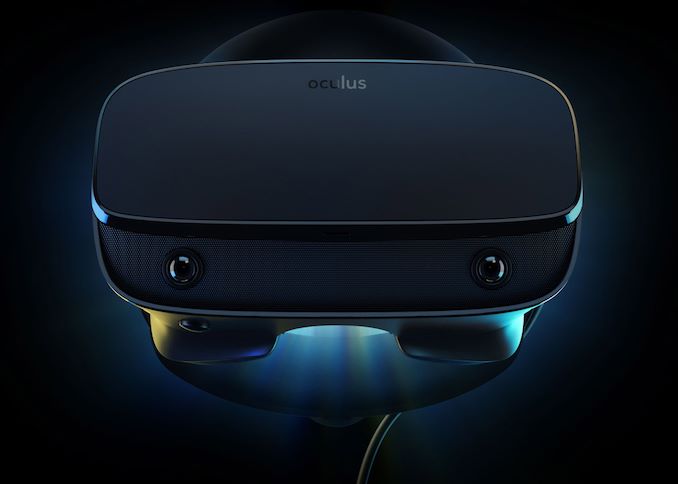Oculus Rift S VR Headset: An Upgraded Virtual Reality Experience
by Anton Shilov on March 20, 2019 2:45 PM EST- Posted in
- VR
- Oculus Rift
- Oculus
- Oculus Rift S

Oculus VR has introduced its new Oculus Rift S virtual reality PC-powered headset. The new head mounted display (HMD) features an inside-out tracking and does not require any external sensors. In a generational update, it has a higher-resolution screen when compared to the original Oculus Rift. The new unit will ship this Spring.
Co-designed by Oculus VR and Lenovo, the Oculus Rift S is a natural evolution (not a major upgrade) of the original HMD that improves it in almost every aspect, including quality of VR experience, a more convenient tracking, and even better ergonomics. The original Oculus Rift and the Oculus Rift S will share the same core platform, enabling owners of both to access VR content developed for either HMD. In fact, even PC requirements for both headsets are the same.
The Oculus Rift S VR headset is equipped with a brand-new display featuring a higher pixel density than before as well as an all-new optics with improved Fresnel lenses for more vivid colors. The company does not disclose resolution of the new HMD officially, but there are claims that the device uses a 5.5-inch display panel with a 2560×1440 (538 ppi, 1280×1440 per eye) resolution and an 80 Hz refresh rate, which is also found inside the Oculus Go. As for audio, the unit has an integrated near-ear speakers in addition to a headphone jack.
The new headset also comes with a built-in inside-out 6-degree-of-freedom (6DoF) Oculus Insight positional tracking (designed for the Oculus Quest) and therefore does not need any external sensors like the original Oculus Rift. Apart from internal sensors, the HMD has five inside-out tracking sensors to track the new Touch controllers and let users observe their surroundings without taking off the HMD.
Because of its collaboration with Lenovo, Oculus VR has managed to develop a headset with a better weight distribution and a more convenient head strap, the company said.
Oculus VR intends to start selling the Oculus Rift S VR headset this spring at a price of $399. The company does not specify the exact launch date, but the wait should not be too long.
Related Reading:
- Oculus Quest Announced: A 6DoF Standalone VR Headset
- Oculus Go Now Available: Mainstream Standalone VR Headset Starts at $199
- HTC Vive Pro HMD Pre-orders Start Today for $799; Vive Reduced to $499
Sources: Oculus, Adam Savage’s Tested, TechCrunch, The Verge












24 Comments
View All Comments
PeachNCream - Thursday, March 21, 2019 - link
They have to release something to refresh the line or Facebook is going to have to answer for why the company acquired Oculus to begin with on the falling edge of this iteration of VR (admittedly that's mostly to Zuck, but it does have enough other shareholders that are willing to apply pressure). Anyhow, the shortcuts they're taking with the hardware can be explained thusly - It's a more cautious product intended to fatten margins to contend with fewer than expected sales of the prior iteration.Samus - Thursday, March 21, 2019 - link
No price increase over the last version!? Blasphemy. Apparently they didn't get the memo from other tech giants!flyingpants265 - Thursday, March 21, 2019 - link
Ever try one of these headsets? Pixel density is too low, but FOV is WAYYYYYY too low. It looks like you're peeping through a keyhole, it's not even remotely immersive. Fix FOV and then we'll talk about spending hundreds of dollars for your toy.Beaver M. - Thursday, March 21, 2019 - link
Everyone was hoping they would fix all that in the new generation. But guess we have to wait a few generations more, if VR doesnt die on the way.